A prism scope is part of the red dot sight category. Usually, one can’t tell the difference between a prismatic or a reflex sight, so what is a prism scope and how do you tell them apart?
Prism scope, prismatic scope, prism sight, and prismatic sight. They’re all terms for the same thing – an aiming optic that uses a prism (hence the name) to bring a right-side up image from a compact, short, and lightweight package.
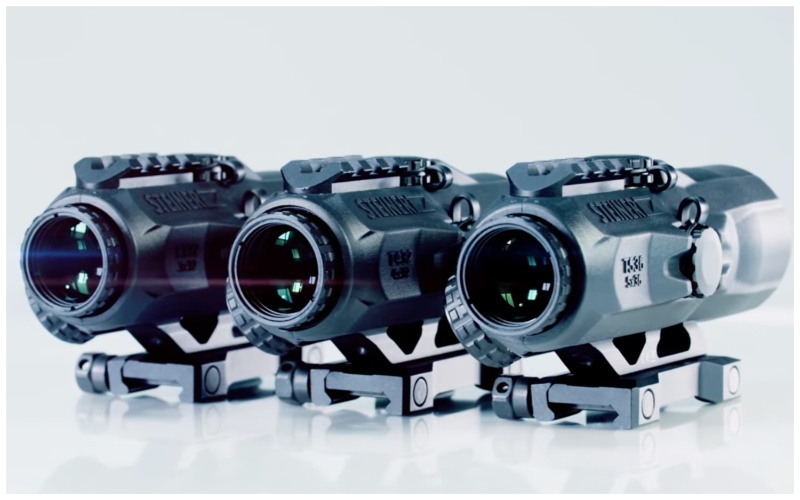
It’s a red dot. But the internals of how it works can make the difference for astigmatism, and it can add a little more magnification to see better and further.
Let’s scope the ins and outs, the nuts and bolts, the pros and cons of prism scopes.
What is a Prism Scope & How Does a Prism Scope Work?
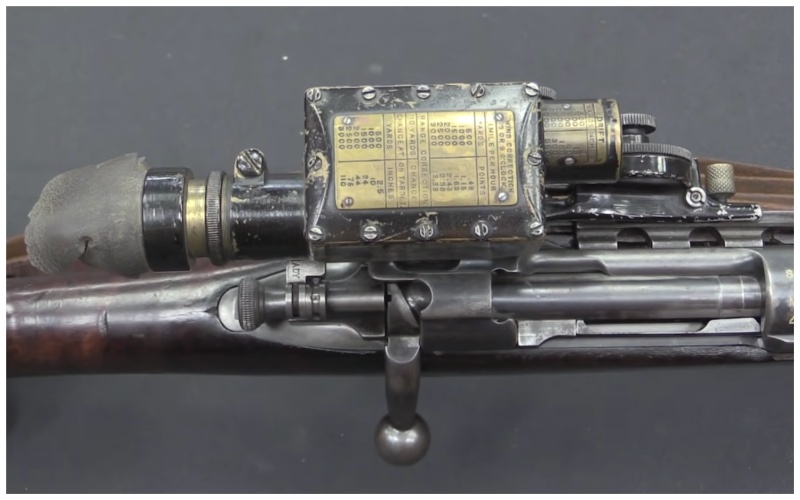
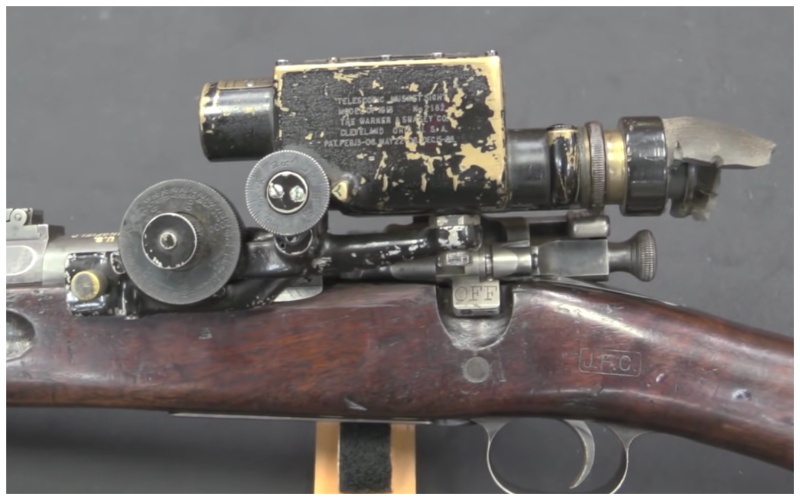
Technically, prism scopes have been around for a really long time – like during World War 1. The very first one certainly looks odd by today’s standard. These days (thank you to the advancements in technology!), they don’t look a whole lot different to reflex sights at all.
Fun fact, the first prism sight was developed and used on the M1903 Springfield, and we have a lineup of the best scopes for a 30-06 here. Back to the point, the first one was offset to the side so that there was clear access to the bolt and chamber. You could still use iron sights with it too!
Nowadays, they’re mostly used on an AR-15 for close-range engagements, home defense, law enforcement, and even some hunting. So, what’s the purpose of a prism sight and how does it work?
Prisms Inside a Prism Scope: How it Works
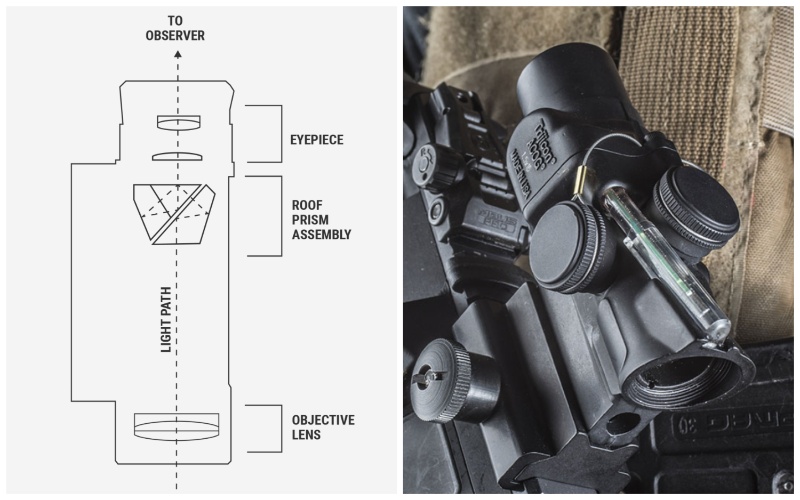
A prism sight uses exactly what it appears to use - prisms. This is in addition to the objective lens, ocular lens, and a glass-etched reticle lens. Light travels in through the objective lens where it folds several times within the prisms to then exit through the reticle and eyepiece to the eyes.
This provides an image that is right side up. It can be focused for those with mild refractive error conditions. A black reticle is visible when illumination has not been activated or if the battery dies.
Prism Sight Features
Cost
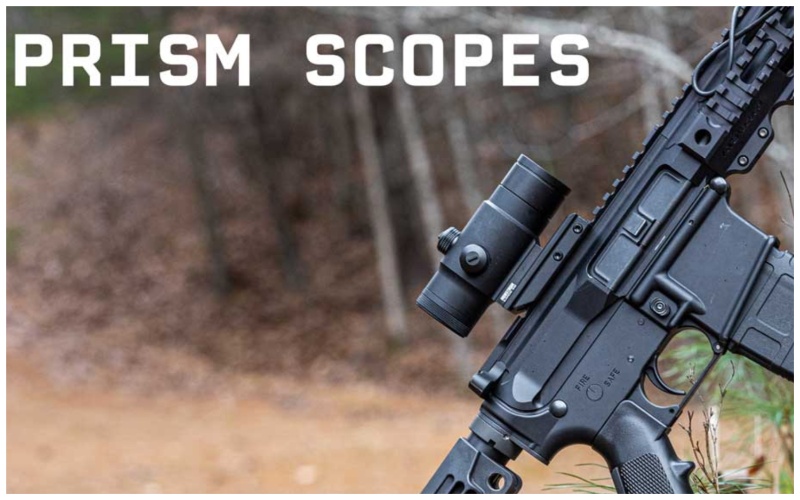
Overall, entry-level prismatic sights are more expensive than entry-level reflex red dot sights. This means that they start at a higher price point compared to a reflex sight. Due to the more complicated design of the prism scope, it makes sense. Prism sights generally start at around $100.
Magnification
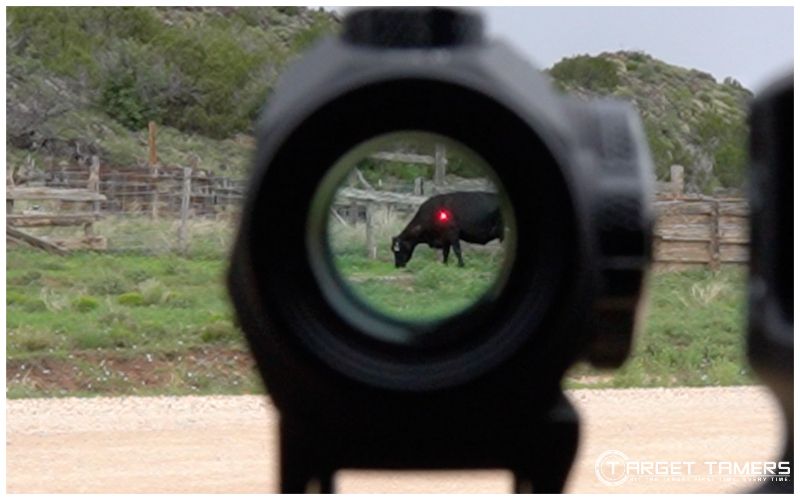
A huge benefit of having prisms in an optical system is that an image can be magnified. Keeping things simple and lightweight, prism scopes have fixed magnification that ranges between 1x-5x. this is not the rule as there are higher-powered prism scopes though few. But the norm is low magnification.
Reticle Visibility
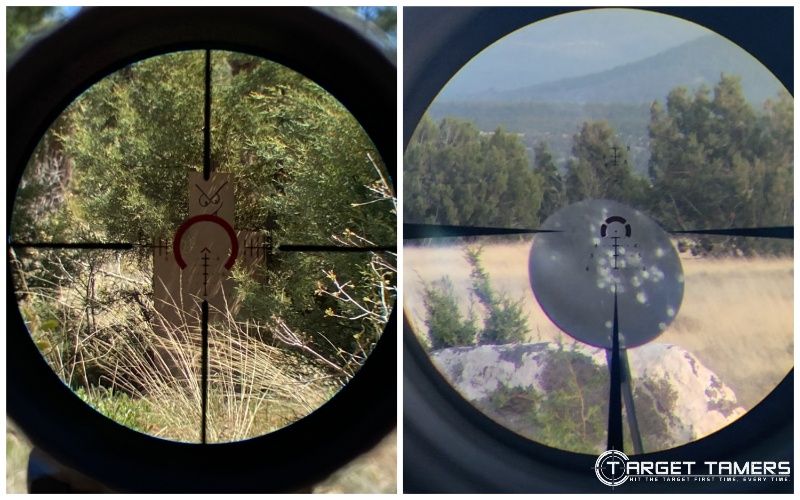
A prism scope’s reticle is highly visible in black when it’s not illuminated. This means that you can still use the sight even if you don’t activate the illumination or if the battery dies/fails.
Illumination can be red, green, or amber – depending on the manufacturer and model. It’s illuminated either by an LED that requires a power source or fiber optics and tritium that don’t require a battery. Some models have night-vision compatible settings.
The reticle in a prism sight is typically laser-etched onto a glass lens. This makes the reticle practically indestructible versus wire reticles. However, if the scope suffers from severe shock or damage, the lens can misalign or break.
Reticle Options
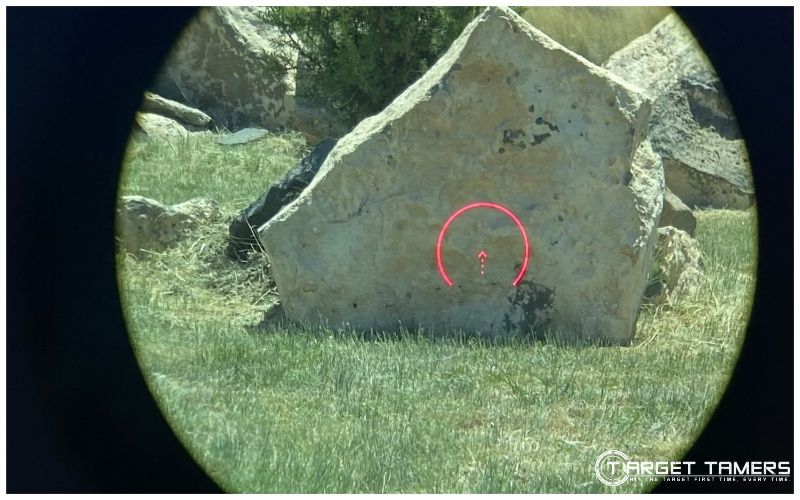
Prism scopes may be desired for their red dot sight benefits, but they also have the advantage of having a different reticle than the oft-used dot. There are reticle variations between dots, chevrons, horseshoes, circles, BDC, and more.
Though having reticle options is a key benefit to choosing a prismatic scope, the goal is to keep it simple. There’s no need for complicated and excessive long-range drop and wind holdovers on a red dot sight. The idea is to maintain fast target acquisition, enhanced situational awareness, and accuracy from close to mid-range distances – usually up to around 300 yards.
Compact & Lightweight
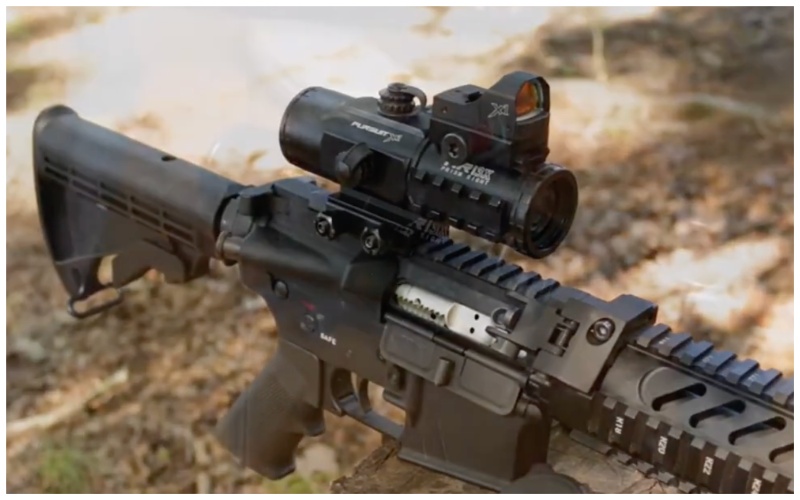
In general, prism sights are larger and heavier than reflex red dot sights, but not always. The prism system may require a longer mounting length and adds a few more ounces to the overall weight. However, they can be so compact and small that it’s easy to mistake them for a reflex sight.
Diopter
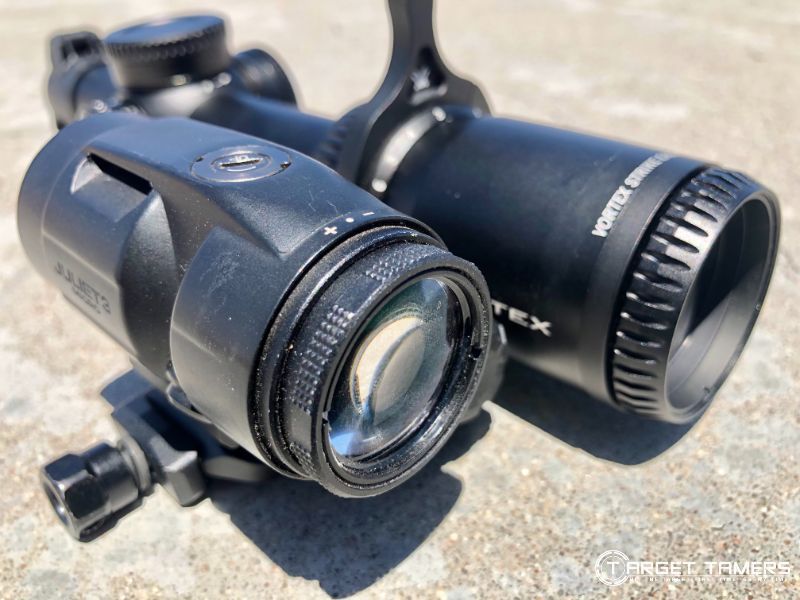
The diopter is an adjustable eyepiece that allows you to acquire sharp focus of the reticle. This is an ideal mechanical feature for those with refractive error conditions.
Being far-sighted, I appreciate a diopter else I see things blurry through the sight – including the target and what’s downrange.
The main thing when looking for a prism scope while considering the diopter is the dioptric range. Some may be limited to only -/+ 2 correction – not a whole lot.
Mounting Systems
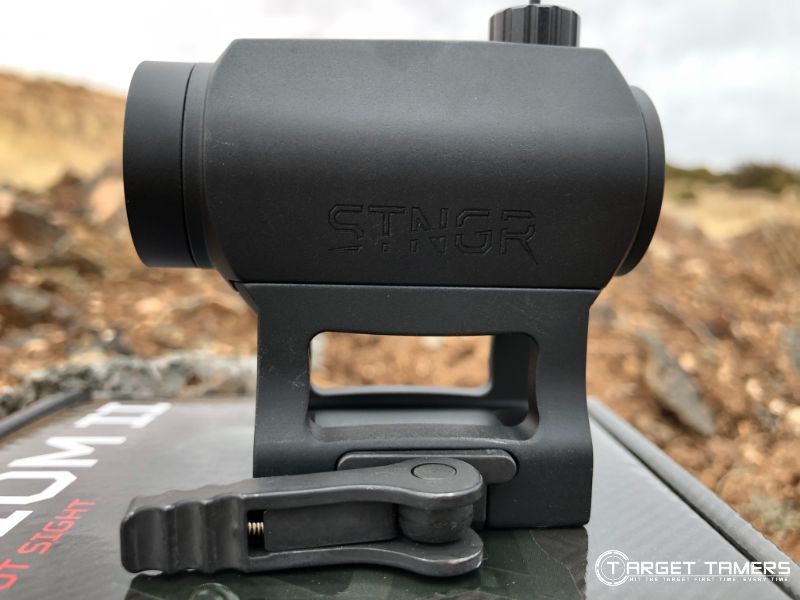
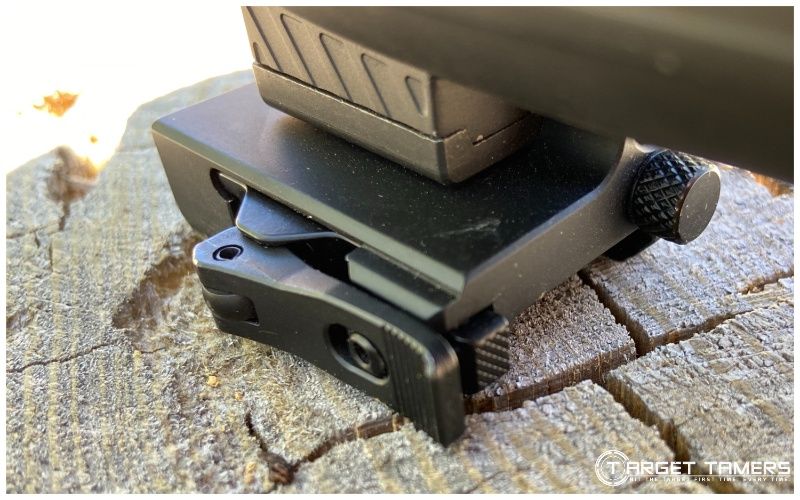
Just like reflex red dot sights, prism sights also come with a mount. This is usually a rail mount that fits Picatinny or Weaver rails. They may be standard mounts that require you torquing it down with a tool or a quick release mount with a lever.
Some mounts are skeletonized to shave weight and provide a tacti-cool appeal. Some manufacturers may include a multi-height mounting system in the box. This usually entails a low-profile mount for systems like shotguns, muzzleloaders, Ruger 10/22, etc. The other mount is a standard height mount.
Prism Sight Limitations
Eye Relief
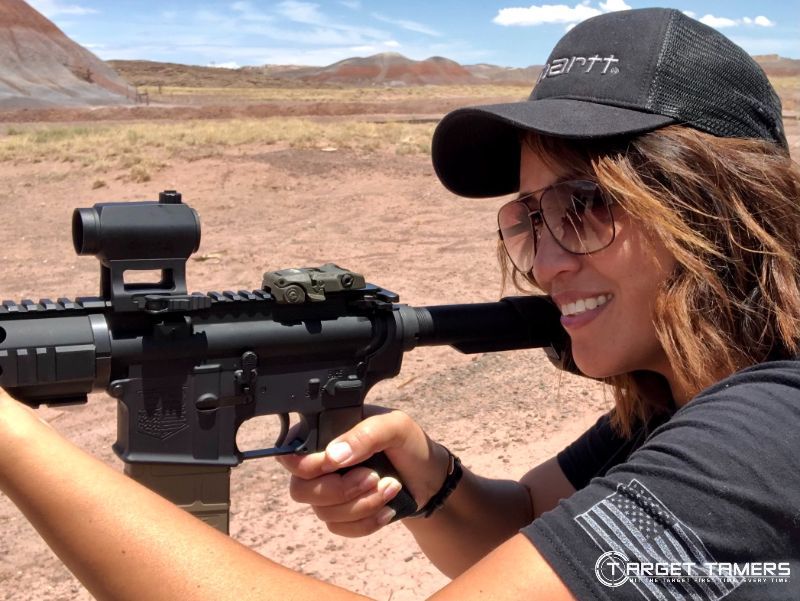
Reflex sights have unlimited eye relief, and you can mount it anywhere along the upper receiver. It’s a little hard to swallow that a prism sight can’t do the same even though it’s a red dot sight. The prism system requires the eye to be at the correct eye relief distance to acquire the sight picture.
Eye relief specs vary from manufacturers to models. They’re generally in the 2-4” range. The eyebox could be small, so a consistent weld will help to acquire an unobstructed sight picture.
Two-Eyes Open Shooting
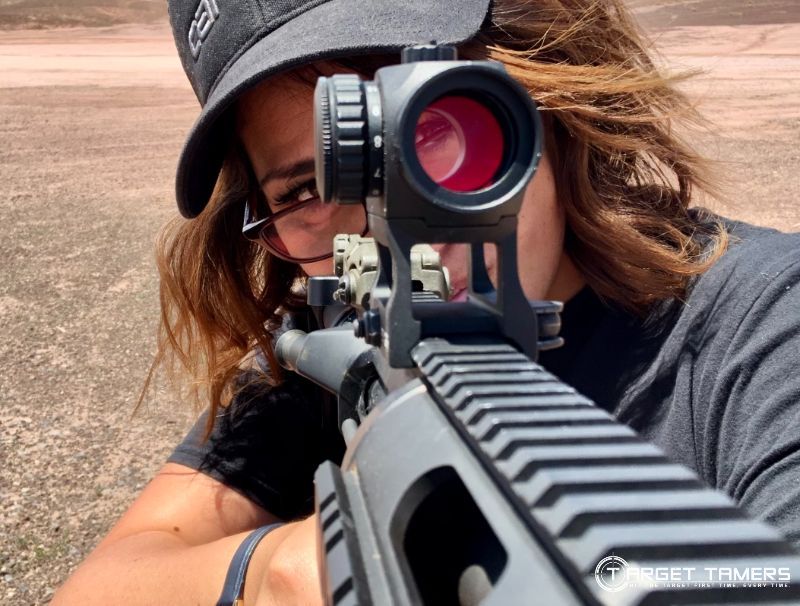
On average, it’s easy to keep both eyes open with a reflex sight and an LPVO at 1x magnification because it’s essentially non-magnified and the wide FOV works better for human binocular vision. Though shooting with both eyes open improves situational awareness, it’s harder to do with a prism sight.
It’s not impossible, but it’s harder because of the magnification. Some exceptions to the rule are Trijicon’s ACOG that uses a BAC Bindon Aiming Concept that was developed for two-eyes open shooting. At the end of the day, go with your training and what feels natural.
Parallax
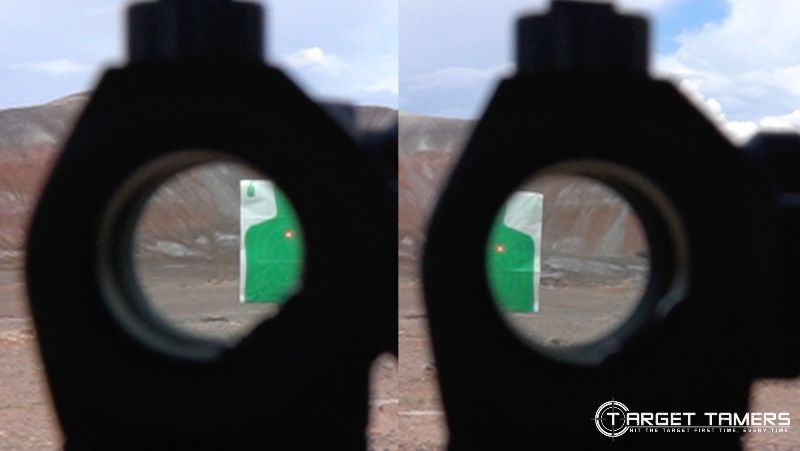
I don’t honestly think any optic is truly parallax free. Yes, the parallax might be extremely small to the point that it’s mostly irrelevant for most of our shooting applications, but prism sights can suffer from parallax just like reflex sights, holographic sights, and riflescopes.
Prism scopes and parallax may be a non-issue inside 200 yards, but it could present itself at longer distances. One way to eliminate parallax altogether is a cheekweld down the optical path of the focal plane.
Fixed Magnification
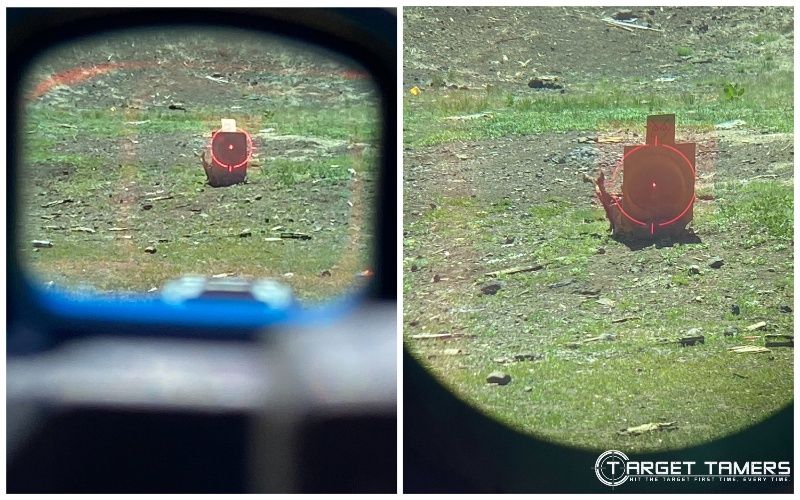
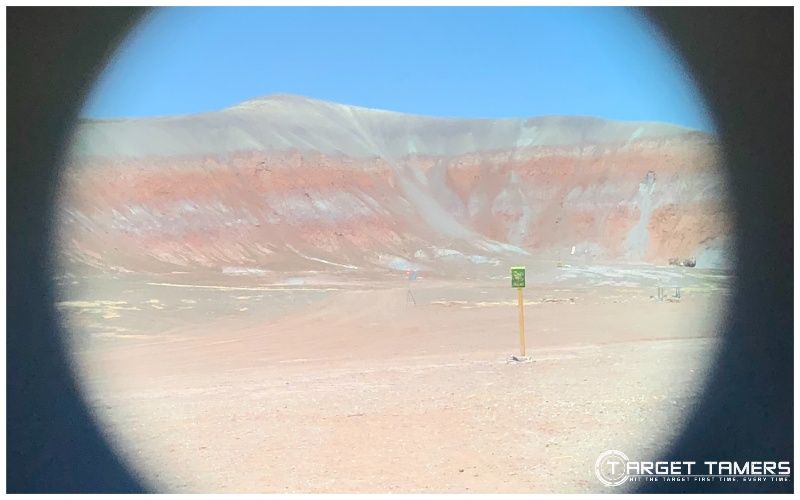
Though having magnification is a primary selling point of the prismatic sight, the fact that it’s fixed may also be a detriment. You can’t change the magnification or quickly go without it when the need arises.
However, a lot of people have a ‘pet’ power range and don’t usually change it anyway. Also, if you have offset irons, this could be a cheap and fast solution for close-quarter shooting when no magnification is desired. You could also just opt for a 1x (non-magnified) prism sight?
Prism Sights VS Reflex Red Dot Sights
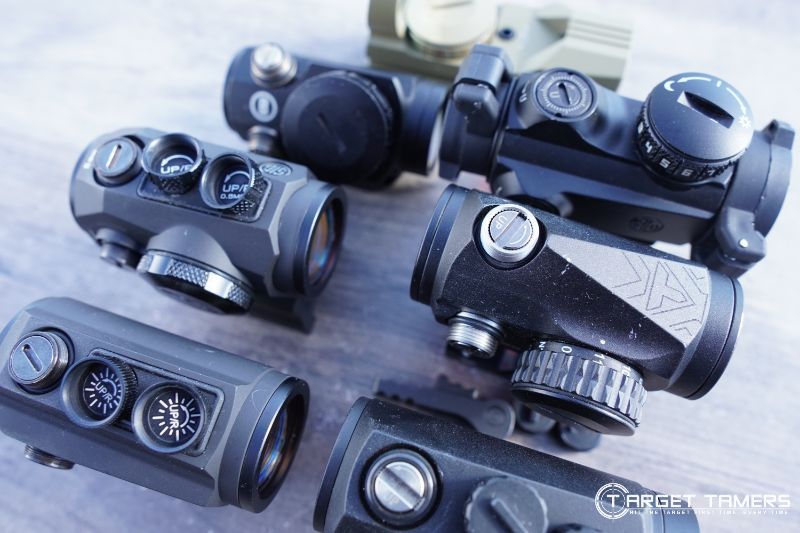
Prism sights use prisms to fold light. The image is magnified, adjustable for vision, and a reticle is visible with or without illumination. In a reflex sight, an LED shines through a stencil form of the reticle (usually a dot) and bounces off the objective lens to exit through the eyepiece.
In a reflex sight, what you’re actually looking at is a reflection of the reticle. The inside of the front lens is coated for reflective properties.
Benefits & Limitations of Prism VS Reflex Sights
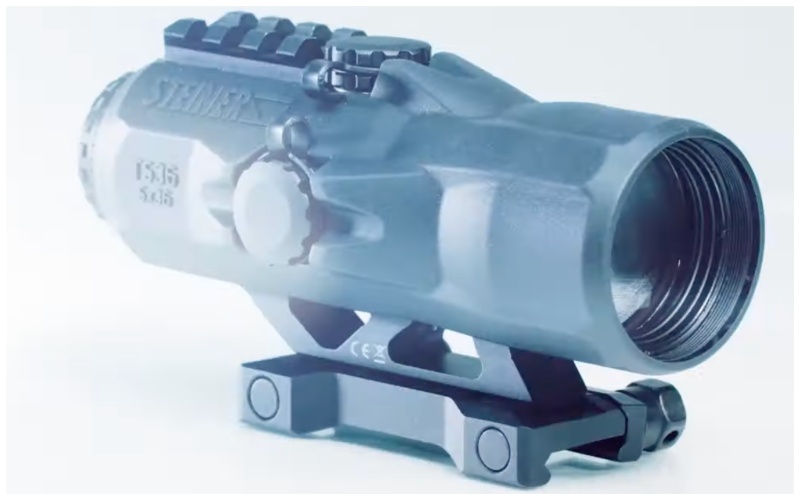
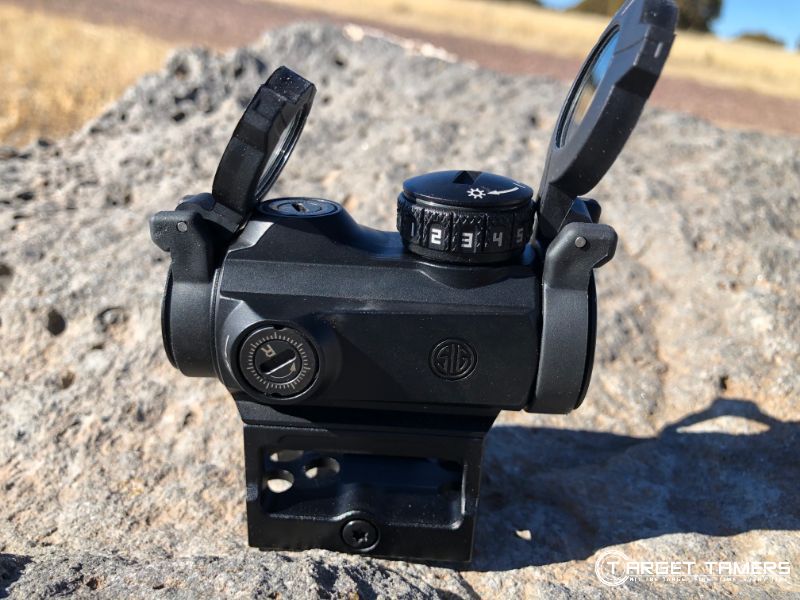
Prism Sights
Pros:
- Fixed magnification
- Can have reticle options
- Works even without illumination
- Doesn’t need a magnifier
- Better for astigmatism
- Adjustable diopter
Cons:
- Not as compact as reflex sight
- Short eye relief
- Can be more expensive than reflex sight
Reflex Sights
Pros:
- 1x magnification (no mag.)
- Smaller than prism sights
- Cheaper starting price point
- Easy to use with two eyes open
- Unlimited eye relief
- Essentially parallax free
Cons:
- No magnification
- Usually only a dot reticle
- Useless if battery fails
- Bad for astigmatism
Prism Scopes VS Riflescopes
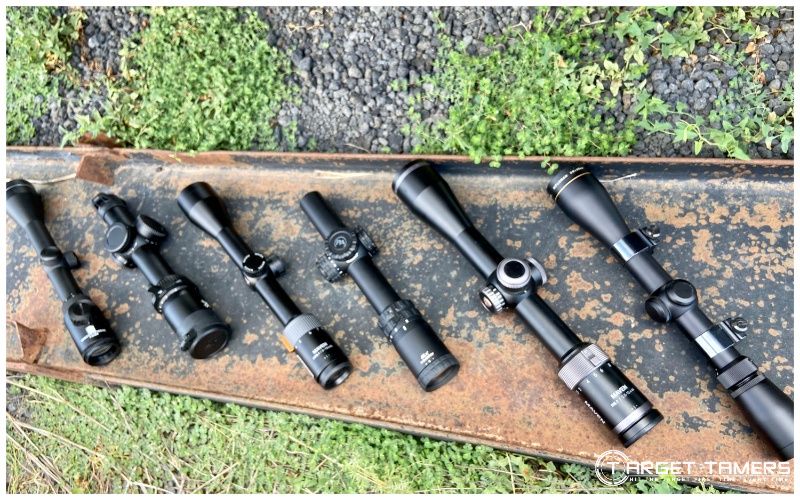
Riflescopes have more than a couple lenses than the somewhat basic prism sight. Riflescopes incorporate an objective lens assembly, ocular lens assembly, magnification assembly, a reticle lens located either before or after the magnification assembly, and an image erector assembly.
Compared to the prism scope, there’s a lot going on. However, the advantage to the riflescope is that it allows for variable magnification and improved precision thanks to the turret assembly that can provide small 0.25 MOA or 1/10 MIL adjustments.
A scope that is usually compared to the prismatic sight is the LPVO (Low Power Variable Optic). Often, the prism sight can be considered the in-between optic of a reflex sight and an LPVO. It's magnified and diopter adjustable compared to the reflex sight but smaller and lighter than the LPV. For more on red dots vs LPVOs, read our comparison guide here!
Benefits & Limitations of Prism VS LPVO Scopes
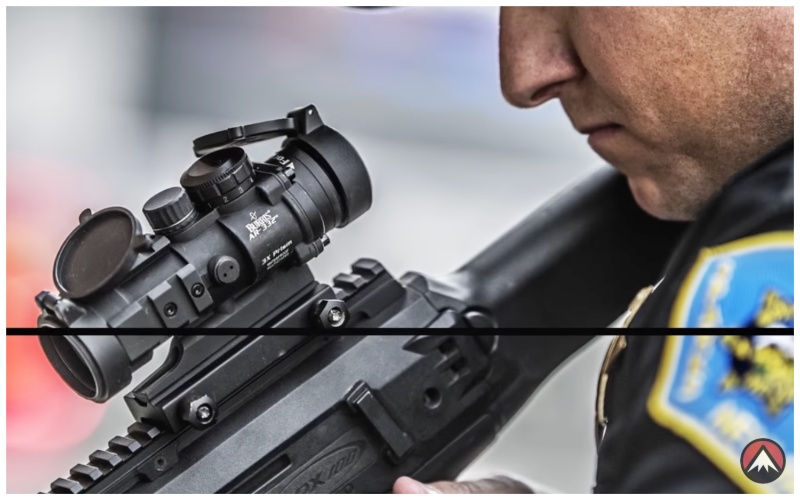
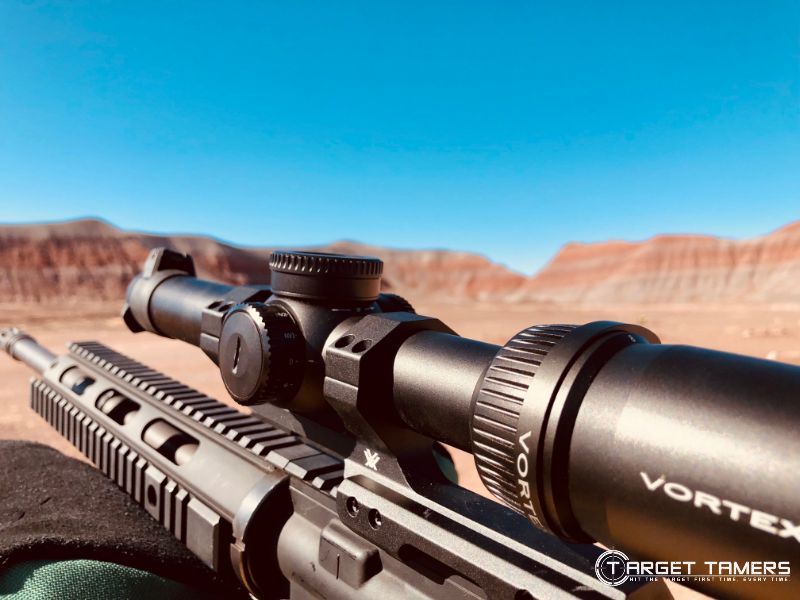
Prism Sights
Pros:
- Fixed magnification
- Compact
- Lightweight
- Easy to use
- Some reticle options
Cons:
- Not as small adjustments as LPVO for precision work
- Can’t change the magnification like an LPV
Reflex Sights
Pros:
- Variable magnification
- Can have a side focus
- Reticle options
- Better for precision
- Close to long-range with ease
Cons:
- Larger & heavier than prism scopes
- Not as fast to use
- Not as easy to use with 2 eyes open
When to Use a Prism Sight
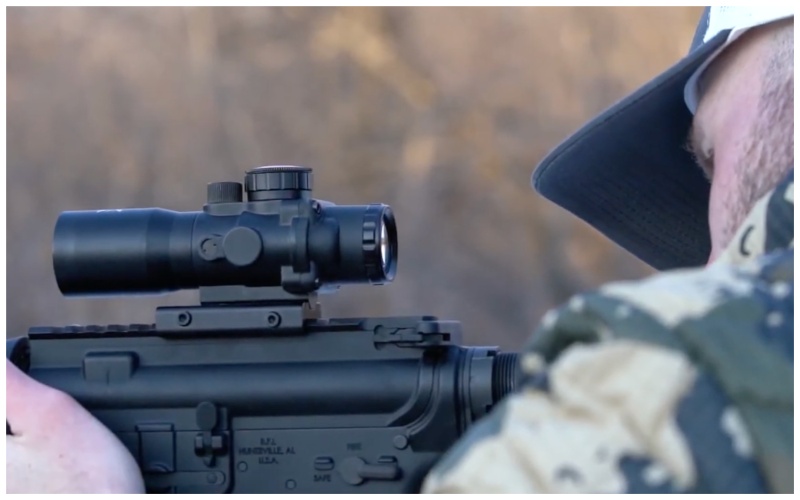
A prism sight is a versatile optic between the reflex red dot and LPVO scope. It’s excellent for close-range work up to 200 yards but can go the distance with the right reticle and magnification combo. Not all prism sights are magnified. They’re lightweight for short carbines and hunting rifles.
Though suitable for the applications listed below, there are some further considerations to deliberate over.
- Target shooting
- Some hunting
- Home defense/SHTF
- Plinking
- Law enforcement
Applications like hunting, extreme-long range, and competition requires a precise, highly accurate setup. Though red dots are often used in the hunt and in shooting matches where appropriate, riflescopes offer better tracking and precision especially at distance.
However, a competition rig compared to a duty/patrol rifle or hunting setup is quite a different matter. Where weight might not be so much of a bad thing in a long-range match, it means a lot to the shoulder that’s carrying it around all day in the brush, buildings, or streets.
A riflescope may be the better option when variable power, distance, and accuracy outweigh the downsides of size and weight.
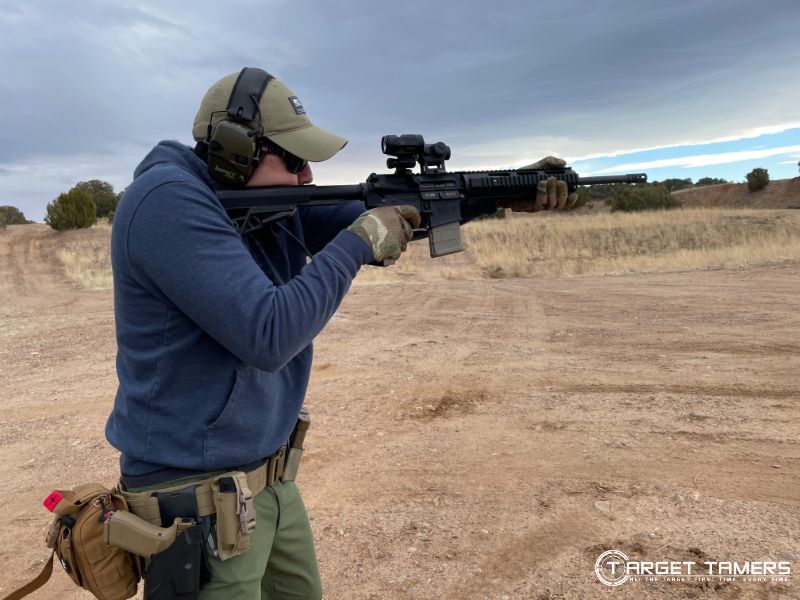
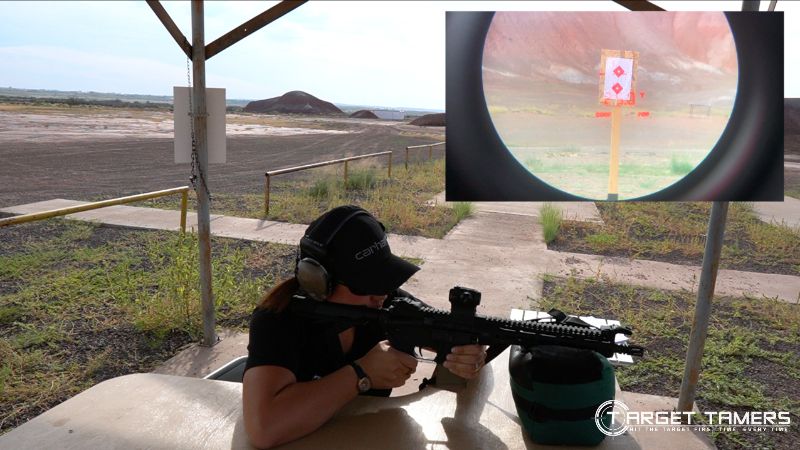
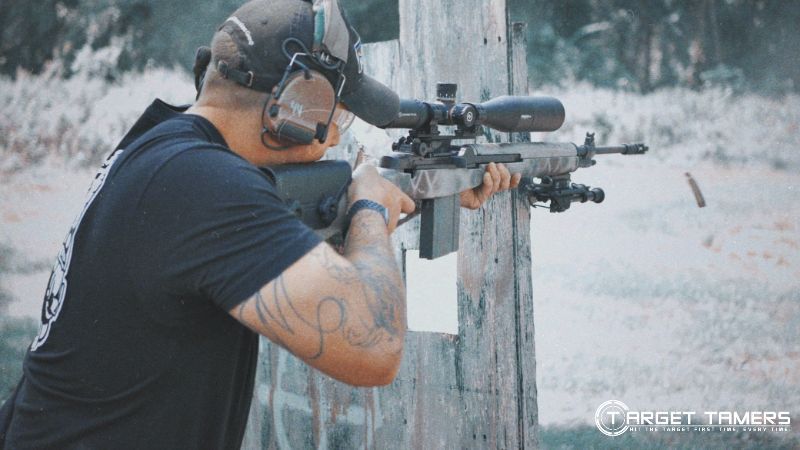
A reflex sight is fast, easy, and simple to use. They’re pretty affordable compared to scopes and the starting costs for quality prism sights. Since they have unlimited eye relief, they’re exceptionally suited to close-range work with two eyes open. However, if you want some versatility or distance of positive identification, you’ll need a magnifier to go with it. Essentially, that eliminates the cost-savings benefit of opting for a reflex red dot sight.
The middle ground is obviously the prism sight. It’s the better option if you’re mostly taking shots inside 200 yards, if you mostly use one magnification setting anyway, and you need a lightweight, compact optic.
Prism Scopes & Astigmatism

Unfortunately, there’s not a whole lot that can be done for shooters with astigmatism short of wearing prescription glasses or contacts. The way that light focuses in astigmatic eyes requires correction, and there’s no amount of correction a shooting optic can provide for astigmatism.
However, the naked truth is that astigmatic eyes don’t like the reflected dot from a reflex red dot sight. The dot distortion can be too distracting for the shooter. Since prism scopes do not use an illuminated reflection of a reticle from a stencil, astigmatic eyes tend to do better with the prism design.
This is because the reticle is glass-etched onto a lens which may help with reticle clarity. Additionally, those that are near or far sighted may be able to compensate for their vision with the adjustable diopter on a prism sight and LPVO.
Opting for a prism sight for astigmatic eyes is not a cure-all, but it may work better for you over reflex or holographic sights.
Best Prism Scopes in 2024
Trijicon ACOG – Best Overall
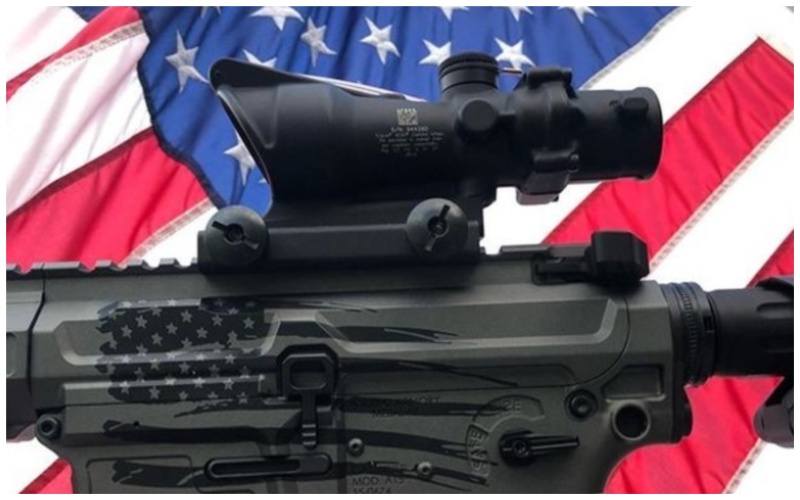
Perhaps the most recognizable prism scope around is the Trijicon ACOG. It’s battle-proven, there are several available models, it goes the distance, and it has battery-free illumination. With multiple configurations from 1.5x-6x power, both eyes open performance, and extreme durability, the ACOG is one of the best examples of a prism sight for those who demand the best for every application.
Vortex Spitfire
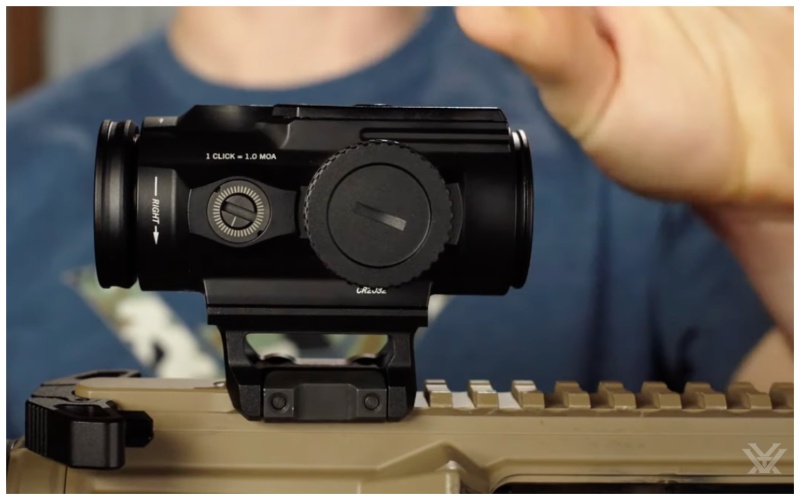
Vortex has a prism sight series called the Spitfire. They offer model options with fixed 1x, 3x, and 5x magnification. Battery life isn’t anything to brag about compared to reflex red dot sights, and the starting price points are higher than some of the most popular reflex sights. However, with prisms in the optical system, the Spitfires have BDC reticles to go the distance, are still very lightweight even in comparison to reflex sights, and you can pick a non-magnified prism scope or a magnified one. Though somewhat expensive, you don’t have to buy a separate magnifier!
Primary Arms SLx MicroPrism
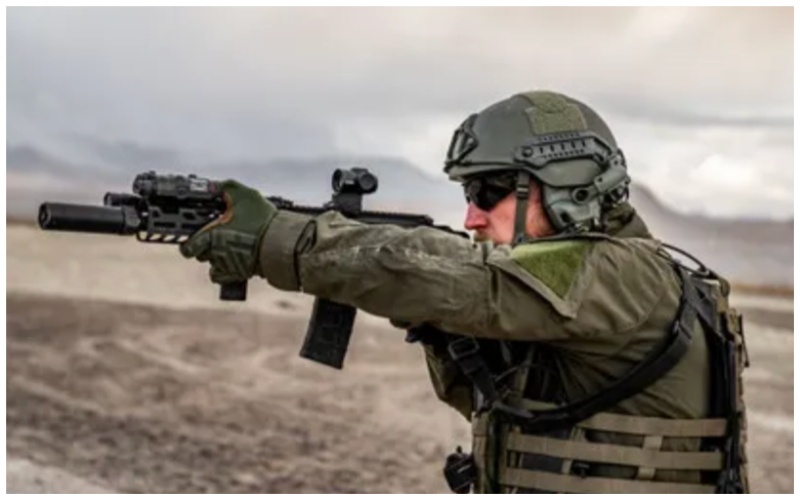
If you’re already familiar with the ACSS reticle from Primary Arms, then you might already be favoring a prism scope from them. They have multiple models with 1x, 2x, 3x, and 5x. There’s a style that will fit everyone’s needs from the forward mounted rail mount to the integrated top rail for an accessory and flat dark earth finishes!
I am a fan of the ACSS reticle myself, and as you might know, there are variations of it from the ACSS Raptor M6 that I field-tested on the GLx 1-6x LPVO to the ACSS CQB reticle on the field-tested SLx MD-25 Gen II with AutoLive reflex red dot sight.
Monstrum Raven
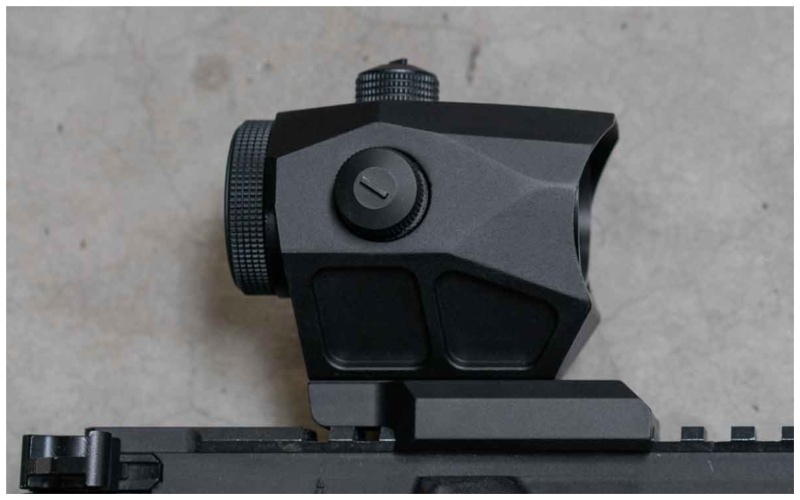
When a tight budget limits the options, Monstrum is a good brand to look to for quality. The Raven series is perhaps one of their most popular prism scope series with 1.5x and 3x magnification sights. It’s incredibly short, compact, and simple. I think that’s pretty much the tag line for Monstrum’s warranty – to keep it simple. I can’t argue with that. In fact, I give it two thumbs up.
Sig Sauer Bravo Battlesights
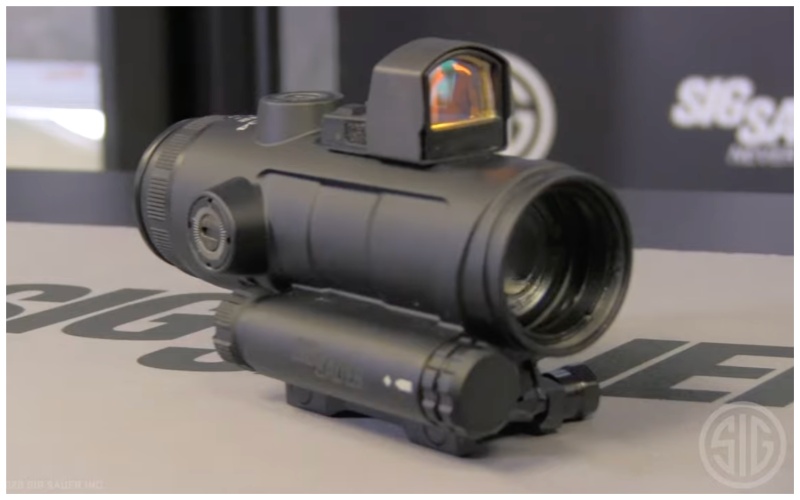
Sig is a manufacturer that uses the “battlesights” term for their prismatic scopes. It sounds awesome. However, the Bravo series are a little pricey – to be expected, but they are equipped with the bells and whistles. With 3x and 5x options, integrated accessory rails, 0.5 MOA adjustments, and skeletonized mounts, they fit the tactical “looks” requirement just as much as they do any performance requirements.
Ozark Armament Rhino 4x R4X-RGB
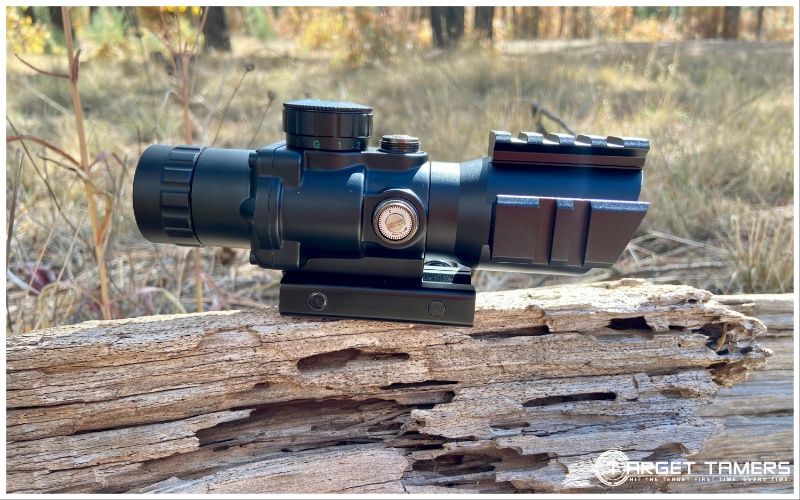
Ozark Armament’s prism sight is the Rhino 4x magnified sight. You could say it’s an ACOG clone, but priced at less than $100, the Rhino 4x is really a winning sight in its own right. It has a glass-etched Rapid Range Reticle that’s on the small side, but it works. With tri-color illumination in the red, green, and blue colors, you won’t be left wanting for variation.
It’s a full-size red dot sight, so it’s not comparable to compact micro prism sights, but it’s still lightweight at 9.6 oz with a 5” length. I am a huge fan of the integrated rails for accessories. This made it ideal for my Bushmaster Patrolman that doesn’t have rails on the handguard. For the money, the Rhino 4x is one of the best budget red dot sights among the cheaper alternatives.
FAQ's
Though most prism sights are magnified with low magnification, not all are magnified. There are 1x prism scopes that share the same 1x (non-magnified) power as a reflex red dot sight. The main differences between a 1x prism scope and a 1x reflex sight will be the optical system and reticle type.
I wouldn’t recommend using a prism scope with a riflescope. The only place I can think of for it would be on an offset mount. I’d think size, space, and eye relief issues would arise with the prism sight in this position.
The effective shooting range of a prism scope will be dependent on the reticle and magnification. Generally, they are ideal for up to 200 yards, but can be taken to mid-range distances between 400-600 yards.
Prism sights are part of the red dot sight category. Red dots include prism, reflex, and holographic sights. The catch-all term is mostly due to the illuminated aiming system (iconically red), effective range for close to medium distances, and the compact optical systems for rapid target engagement.
Prism VS Reflex VS LPVO: Which is Best?
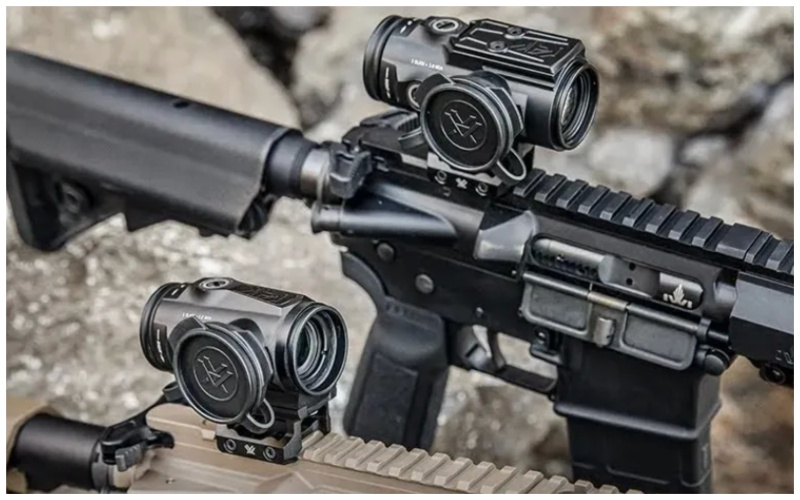
There is no one sight that is inherently better than the other. There is only choosing the right tool for the job. Prism sights provide a good combination of reflex and LPVO features. They’re fast to use, have limited and fixed magnification, and remain compact and lightweight.
Since they use prisms, they can be easier on the eyes for those with astigmatism, and with fixed magnification, they can be a cheaper alternative than a quality LPVO or reflex sight and magnifier combo.
If you want some power for a little bit of distance, a visible reticle with or without illumination, and you want to keep your overall rifle rig light, the prism scope is a great sight to consider.
Featured Image Credit: Vortex
Further Reading



